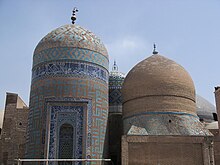Safi ad-Din Ardabili
Safi ad-Din Ardabili also Safī ad-Dīn Is'haq Ardabilī ( Persian شیخ صفی الدین اردبیلی; Eyḫ Ṣafī ad-Dīn Ardabilī ; * 1252 ; † 1334 in Ardabil ) was an Iranian Sufi sheikh . He was the ancestor and namesake of the Safavid dynasty . Other spellings of his name include Safi al-Din , Safi ad-Dîn , Safi Eddin , Safi od-Din , Safi El-Din , Safioddin or Safieddin .
According to the chronology of Silsilat al-Nasab Safawiyya , the traditional family tree of the Safavids (originating in the 17th century), Safī ad-Dīn was the descendant of a certain Firūz Shah Zarrīn-Kullah al-Kordī al-Gilanīs and thus Kurdish - Persian descent.
Safi ad-Din decided at the age of twenty years from Shiraz to go out there with Sheikh Najib al-Din Buzghusch as Murid to go into teaching. But when he got to Shiraz, he learned that the sheikh had died. While looking for a spiritual teacher, he became aware of the Sufi Sheikh Zāhed Gīlānī . In 1276/1277 he found Zāhed Gīlānī in a village on the Caspian Sea and apprenticed to him.
Safī ad-Dīn later became the son-in-law of Zāhed Gīlānī and married his daughter Bibi Fatima. Safī ad-Dīn was also the heir of Zahed Gilani and after his death in 1301 took over the leadership of the Sufi order of the Zahediyya, which he later renamed Safawiyya . This succession aroused great resentment among the followers of Zāhed Gīlānī, and especially his sons. Safi ad-Din is buried in the area of his Sufi "monastery" .
Works
Some collections of poetry have survived from Safī ad-Dīn, of which the “Dobayt” collection (“double verses”) in particular has linguistic significance today. Most of them were written in the ancient Azerbaijani language , which was one of the Central Iranian languages , and to a lesser extent in Persian .
Notes and sources
- ^ Barry D. Wood: The Tarikh-i Jahanara in the Chester Beatty Library. An illustrated manuscript of the "Anonymous Histories of Shah Isma'il". Islamic Gallery Project, Asian Department Victoria & Albert Museum London, Vol. 37, No. 1, March 2004, pp. 89-107.
- ↑ Persia (History of the New Persian Empire) . In: Meyers Konversations-Lexikon . 4th edition. Volume 12, Verlag des Bibliographisches Institut, Leipzig / Vienna 1885–1892, p. 873.
- ^ Roger Savory: Ebn Bazzaz . In: Ehsan Yarshater (ed.): Encyclopædia Iranica . Volume VIII (1), p. 8 (English, including references)
- ↑ Ehsan Yarshater : The Iranian Language of Azerbaijan . In: Ehsan Yarshater (ed.): Encyclopædia Iranica . Volume III (3), pp. 238–245 (English, including references)
| personal data | |
|---|---|
| SURNAME | Ardabili, Safi ad-Din |
| ALTERNATIVE NAMES | Ardabilī, Safī ad-Dīn Is'haq Ardabilī |
| BRIEF DESCRIPTION | Islamic clergyman |
| DATE OF BIRTH | 1252 |
| DATE OF DEATH | 1334 |
| Place of death | Ardabil |

